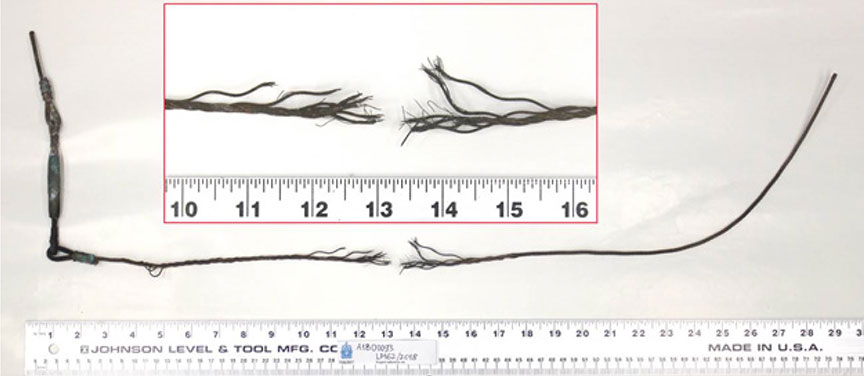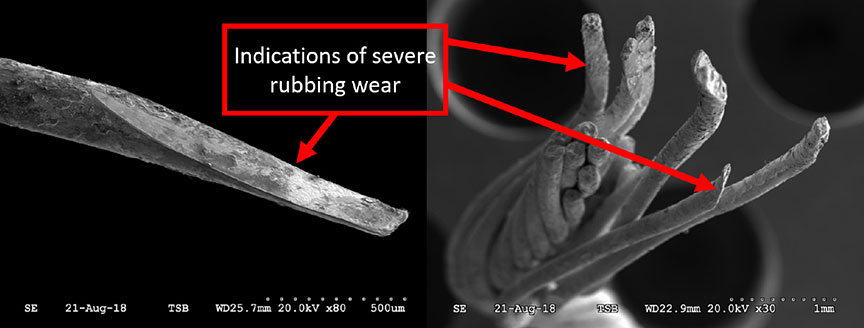Collision with terrain
Champion 7GCAA, C-FXTJ
Deer Lake, West Nipissing, Ontario
The Transportation Safety Board of Canada (TSB) investigated this occurrence for the purpose of advancing transportation safety. It is not the function of the Board to assign fault or determine civil or criminal liability. This report is not created for use in the context of legal, disciplinary or other proceedings. See Ownership and use of content. Masculine pronouns and position titles may be used to signify all genders to comply with the Canadian Transportation Accident Investigation and Safety Board Act (S.C. 1989, c. 3).
History of the flight
On 08 July 2018, the privately registered float-equipped Champion 7GCAA (serial number 4, registration C-FXTJ) departed for a local flight from Deer Lake, near West Nipissing, Ontario.
Both tandem seats (one seat behind the other) were equipped with a control stick, so the aircraft could be flown from either seat. On board were the owner of the aircraft, who was seated in the front seat, and a passenger, who was seated in the rear seat.
After a routine water takeoff, the aircraft climbed and began flying around the lake. It then levelled off and the flight path appeared to be normal until the aircraft turned northbound over land. Shortly after passing the shoreline, the aircraft pitched nose up to a point where the top of the wing could be seen from the ground; the pitch continued to increase until the right wing dropped. The aircraft then began to rotate along the longitudinal axis in a steep nose-down attitude, and continued rotating until it struck the ground, at approximately 1728.Footnote 1 A fire erupted and consumed the aircraft. The 2 occupants were fatally injured. Witnesses near the accident site arrived on the scene and called 911.
Pilot information
The pilot was certified and qualified for the flight in accordance with existing regulations. He began flying in 1990. From that time until September 2014, he had recorded 695 total flight time hours in his personal logbook. Since September 2014, he had flown an additional 22 hours on the occurrence aircraft, which had been recorded in the aircraft journey logbook. The pilot had flown other aircraft since September 2014; however, the total number of hours could not be determined, because they were not recorded in his personal logbook.
The investigation did not identify anything to indicate that the pilot's performance was degraded by physiological factors.
Weather information
North Bay Airport (CYYB), Ontario, located 34 nautical miles east of Deer Lake, recorded the weather conditions at the time of the occurrence as follows:
- wind: 240° true at 12 knots, gusting to 22 knots
- visibility: 30 statute miles
- ceiling: 32 000 feet above ground level
- temperature: 26 °C, dew point 11 °C
- altimeter setting: 30.12 inHg
Informal, but localized, reports describing the weather conditions were obtained, indicating sunny, clear skies, gusty wind conditions of 40–60 km/h, and white caps on the lake. Weather was not considered a factor in the accident.
Aircraft information
The aircraft was manufactured in 1965, and a review of the records indicated that it had accumulated approximately 1700 hours total time since manufacture. It had been converted from wheel-equipped landing gear to floats in August 2015, and since that time, the aircraft had flown approximately 20 hours.
Records indicate that the owner was the only pilot who had flown the occurrence aircraft since it was purchased in August 2011. Since that time, it had accumulated a total of approximately 43 hours. Most of the recorded flights were in the Deer Lake area and were of short duration.
The last annual inspection of the aircraft had been performed on 02 August 2017. Between that date and the accident date, there were only 2 hours of recorded air time. The annual inspection consisted of routine maintenance, including an engine oil change, a cylinder compression check, a compass check, and a main battery replacement. There were no recorded anomalies during the inspection, and the engine was operated and found to be serviceable.
The annual inspection had been signed off by a qualified aircraft maintenance engineer (AME) and it was recorded that the inspection had been carried out in accordance with the maintenance schedule outlined in Canadian Aviation Regulations Standard 625, appendices B and C.
Accident site and aircraft wreckage
TSB investigators attended the accident site and examined the aircraft wreckage. Damage to the surrounding trees indicated that the flight path was near vertical prior to impact. Although the aircraft was almost entirely consumed by fire, it was determined that the aircraft was in a very steep right bank and nose-down attitude when it collided with terrain, right wing first.
The aircraft systems were examined to the degree possible and all flight control surfaces were accounted for. Damage to the propeller was consistent with power being produced at the time of impact, although the amount of power could not be determined.
During the examination of the flight controls, it was noted that the nose-up elevator control cable was frayed and split where the cable would normally travel over the first guide pulley forward of the empennage. The nose-up elevator control cable is a primary flight control cable that raises the elevator when tension is applied, which results in increased nose-up pitch. Both ends of the fractured cable (Figure 1) were recovered and sent to the TSB Engineering Laboratory in Ottawa, Ontario, to determine whether the cable damage had occurred before or during the accident sequence.
Examination of the nose-up elevator control cable
The split cable was examined using a scanning electron microscope. The stainless steel nose-up elevator control cable was made up of 7 wound bundles of wires, each containing 19 individual wires. Although the cable had been damaged in the post-impact fire, the examination was able to determine that there were 2 types of wire separation at the split:
- 81 of the split wires exhibited cup-and-cone fractures. This type of fracture is normally indicative of tensile overload, or more simply, when wires fail under tension.
- 52 of the split wires (39% of the total) exhibited severe rubbing wear (Figure 2), which contributed to the fracturing. These fractures likely occurred prior to the tensile overload.
Previous issues with elevator control cables
Following an accident in Australia on 08 May 2008 involving an elevator control cable failure on a similar Champion 7GCBC aircraft, the Australian Civil Aviation Safety Authority published an airworthiness bulletinFootnote 2 to alert AMEs and operators to the potential for an in-flight failure of the elevator control cable. The failure in the May 2008 accident was determined to have been the result of the cumulative effects of fatigue cracking and non-conformity of the cable to accepted manufacturing standards. The cable in the Australian accident did not, however, show the signs of wear that were evident in the cable involved in this accident.
In the Airworthiness Bulletin, the Australian Civil Aviation Safety Authority recommended to Australian operators or AMEs that
However, the applicability of the bulletin did not extend beyond Australia.
Aircraft maintenance and inspection
The manufacturer's service manual for the Champion 7GCAA,Footnote 4 current at the time of the Australian accident as well as at the time of this accident, contains a maintenance schedule that requires a visual inspection of all control cables at 100-hour and annual inspections.
On 23 May 2018, the manufacturer distributed a service letterFootnote 5 that focused specifically on elevator control cables. The service letter outlined a detailed inspection that expanded on the previously required visual inspections, placed inspection emphasis on the cable at all pulley locations, and provided information on the type of anomalies that may be found. The letter also introduced a requirement to replace the cables at 1000-hour intervals. This service letter was distributed after the date of the most recent annual inspection of the occurrence aircraft.
The annual inspection requirements in Canada for small private aircraft as outlined in Canadian Aviation Regulations Standard 625, Appendix B, state that maintenance inspections must include the inspection items listed in Part 1 of the appendix, or as an option, follow the manufacturer's maintenance schedule, provided all applicable items are included.
With regard to the inspection items listed in Part 1 of the standard, the item that would include control cables states:
This list of inspection items is more detailed when referring to other parts of the aircraft; the landing gear group, for example, is divided into 10 separate and specific items to inspect.
It is common for AMEs to inspect control cables during annual inspections. However, there is no further detail within the standard that would explicitly require these inspections, nor is there any requirement for owners or AMEs of small private aircraft to follow any of the guidance provided by manufacturers in the form of service letters or bulletins.
Safety message
Although it could not be determined with certainty that the nose-up elevator control cable, as a whole, failed in flight, it was determined that several wires within the cable failed due to severe rubbing wear before the remainder of the cable failed in tensile overload.
Primary control cable inspection is not explicitly described within basic annual inspection guidance for small private aircraft. Regular inspection and replacement, as necessary, of these cables could prevent a possible in-flight separation and a resultant loss of control.
This concludes the TSB's limited-scope investigation into this occurrence. The Board authorized the release of this investigation report on . It was officially released on .

